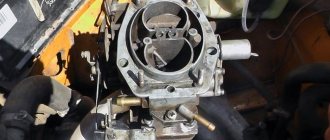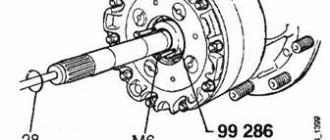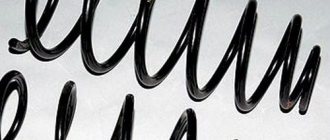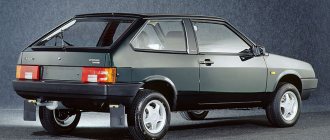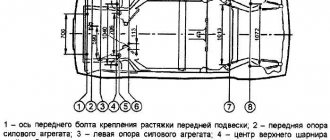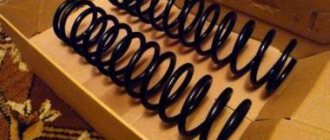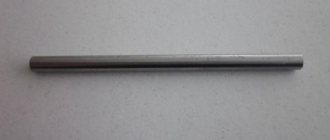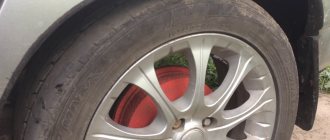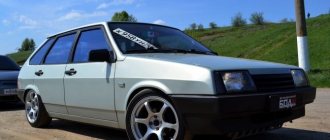Correspondence of spring markings to the model
When installing springs on a VAZ suspension, it is advisable to ensure their compliance.
- 2101 install on rear-wheel drive sedans.
- 21012 is tougher, made from a larger diameter rod. Installed on a VAZ with left-hand drive, with special equipment, when a front suspension with increased energy intensity is needed.
- 2102 are installed on station wagons VAZ-2102, 21014. Their length is increased by 21 mm compared to 2101, so they are installed on sedans only when you often have to drive on country roads so as not to hit bumps - when installing 2102, the ground clearance under body They cannot be used to increase the load capacity, since they inevitably lead to premature destruction of the body.
- 2108 is installed on all front-wheel drive models, except for modifications with a 16-valve engine and Oka. By the way, in the markets they often deceive owners of VAZ-21099 sedans by offering to purchase scarce “99 springs”. In fact, there are ordinary “eighths” there, and “99ths” do not exist at all.
- 2110 European ones are installed on the rear suspensions of VAZ 21102-21104, 2112, 2114, on the front and rear suspensions 21122 and 21124. The European version is created for cars intended for export. The ground clearance here is reduced by 20 mm, the compliance of the springs is reduced in order to increase their stability at high speed when turning. The cross-country ability of vehicles on off-road and dirt roads is significantly deteriorated.
- 2111 are installed on the rear suspensions of VAZ 2111 and 2113.
- 2112 are installed on the front suspensions of VAZ 21103, 2112, 21113.
- 2121 is used on all-wheel drive models, except Oka.
We select springs according to markings
So, a man came to the store to buy new springs. Which option should I choose? The decoding of the markings presented below will help with this:
- 2101. Ideal for all sedans equipped with rear-wheel drive;
- 21012. A very rigid product, which is usually used on special vehicles;
- 2102. First of all, intended for domestic station wagons. When installing this option, the vehicle's ground clearance increases, which is very important if the vehicle is used off-road;
- 2018. Usually installed on any variant with front-wheel drive, except for Oka and those cars that have a 16-valve power unit under the hood;
- 2110. Designed for expert versions of domestic models from VAZ;
- 2111. Used on models such as VAZ 2111 and 2113. Only on rear suspensions;
- 2112. Similar to the previous version, only for the front suspension;
- 2121. Typically used on four-wheel drive vehicles only. First of all, this is a domestic Niva.
Differences between suspension springs and their markings
The main identification parameter of any spring is its outer diameter. Manufacturers cannot change it spontaneously, since this size is determined by the design features of the car itself. All other parameters can be completely different. So manufacturers can:
- change the diameter of the rod from which it is made and even use a rod that has a variable diameter;
- produce springs of the same height, but of different stiffness;
- change the interturn distance and number of turns while maintaining rigidity.
Therefore, factories monitor the static load before installation. This operation is carried out as follows: measure the height of the spring by compressing it with a certain force. Since for each specific car model the compressed height is regulated by a tolerance field, parts that do not fall into this field are rejected.
Springs that fall within the upper tolerance range are classified as class A (long), and those that have a height within the lower tolerance range fall into category B (short). Next, springs of the same class are marked with paint, and the color of the marking depends on the model of the car on which they are to be installed.
- Class A springs of VAZ cars are marked by color with yellow, white, brown and orange paints.
- Type B is also marked by color, but with green, blue, blue and black paints.
Color marking is applied to the outer side of the turns in the form of a colored stripe. The abundance of colors of marking paint is explained by the fact that in order to reduce the effect of corrosion, they are subjected to a special coating (chlorinated rubber enamel or protective epoxy coating), which also comes in different colors (black, gray, blue, white, light blue) and determines both the car model and and the purpose of the spring (front or rear). Moreover, in factories that produce various VAZ and Lada models, the front elements are painted, as a rule, black. The only exceptions are springs with variable interturn distance (pitch) - they are painted blue.
Spring sizes of domestic cars
The article indicates the sizes of springs used in domestic cars
The actual data in the table
| Spring | Auto | Rod diameter, mm, tolerance 0.05 | Outer diameter, mm / Tolerance | Spring height, mm | Number of turns | Spring color | Rigidity | Marking color |
| Front | 1111 | 10 | 94 / 0,7 | 317,7 | 9,5 | black | — | — |
| 2101 | 13 | 116 / 0,9 | 360,0 | 9.0 | black | A - standard | Yellow | |
| B - soft | Green | |||||||
| 2108 | 13 | 150,8 / 1,2 | 383,5 | 7,0 | black | A - standard | Yellow | |
| B - soft | Green | |||||||
| 2121 | 15 | 120 / 1,0 | 278,0 | 7,5 | black | A - standard | Yellow | |
| B - soft | Green | |||||||
| 2110 | 13 | 150,8 / 1,2 | 383,5 | 7,0 | black | A - standard | Red | |
| B - soft | Blue | |||||||
| 2141 | 14 | 171 / 1,4 | 460,0 | 7,5 | grey | — | — | |
| 3110 | 15 | 90 (89) / 0,5 | 400,0 | 10,0 | black | — | — | |
| Rear | 1111 | 10 | 100,3 / 0,8 | 353,0 | 9,5 | grey | — | — |
| 2101 | 13 | 128,7 / 1,0 | 434,0 | 9,5 | grey | A - standard | Yellow | |
| B - soft | Green | |||||||
| 2102 | 13 | 128,7 / 1,0 | 455,0 | 9,5 | grey | A - standard | Red | |
| B - soft | Blue | |||||||
| 2108 | 12 | 108,8 / 0,9 | 418,0 | 11,5 | grey | A - standard | Yellow | |
| B - soft | Green | |||||||
| 21099 | 12 | 110,7 / 0,9 | 400,0 | 10,5 | grey | A - standard | Red | |
| B - soft | Blue | |||||||
| 2121 | 13 | 128,7 / 1,0 | 434,0 | 9,5 | grey | A - standard | White | |
| B - soft | Black | |||||||
| 2110 | 12 | 108,9 / 0,9 | 418,0 | 11,5 | grey | A - standard | White | |
| B - soft | Black | |||||||
| 2141 | 14 | 123 / 1,0 | 390,0 | 9,5 | grey | — | — |
The color of the spring is not a constant value. Different manufacturers may change this color. The thickness of the rod is also a question; for example, Phobos makes springs even with variable rod thickness. He (Phobos) makes springs with variable pitch, therefore, cannot withstand the specified number of turns. The height can also vary, because... Some manufacturers, to simplify the technology, make the rear springs 2101 and 2102/04 the same height, but of different stiffness. Other manufacturers reduce the height to increase the stability of the car in corners. Therefore, to identify springs, it is most appropriate to use the outer diameter of the spring, because this size is attached to the car, and spring manufacturers cannot change it arbitrarily. Springs of the same diameter can be distinguished by the color of the marking, because... this is also an established standard with some tolerance for color perception (for example, red = brown).
The article is based on data from the site https://abvgd-auto.narod.ru
Important
Class A, as well as class B, have an absolutely equal right to exist. Color marking was introduced in order to eliminate the difference in their height on opposite sides of the car. After all, installing springs of different heights on both sides of one car axle will lead to a deterioration in its handling and stability, and will also lead to rapid failure of chassis parts.
Experts recommend using springs of only one class. It is allowed to use class A in the front suspension, and class B in the rear. If class B springs are used in the front suspension, then installation of class A in the rear suspension is strictly prohibited. In any case, springs of both the same type and the same class must be installed on one axis.
About springs... — Lada 21099, 1.5 l., 2003 on DRIVE2
Not long ago I thought about lowering the car (slightly), but I don’t want to buy lowered shock absorbers and springs. I understand that it’s easier to buy some phobos, SS-20, and not bother with calculations, but I went this route. To do this, a large amount of information about springs installed on domestic cars was collected, analyzed and presented in this article. So, in addition to the fact that springs differ depending on the brand of car they are installed on, there is also a breakdown into classes of springs. Since the springs cannot be made perfectly identical, when controlling the static load, their length may vary, so those springs that turn out to be slightly longer than the nominal ones are assigned class “A”, while those that are slightly smaller are assigned class “B”. The difference in the maximum load on springs of class “A” and class “B” is up to 25 kg. It should be noted that all 4 springs must be of the same class - either “A” or “B”. It is also possible to install class “B” springs in the rear and class “A” springs on the front axle, but vice versa is not possible. It is also unacceptable to install springs of different classes on the suspension of one axle. The class of a spring can be determined depending on the color of the marking applied to the springs (Tables 1,2).
Front suspension spring markings
Rear suspension spring markings
The main characteristics are shown in the tables below.
Main characteristics of front suspension springs
Main characteristics of rear suspension springs
Thus, it is possible to install the following suspension: Front springs: Izh 2126 rear suspension springs Rear springs: VAZ 2101 front suspension springs
Result: The rear of the car will drop by about 55-60 mm, the front will remain at the same level, but the suspension will become approximately 2 times stiffer. LoonyRomantic had this configuration: “on big bumps the rear lifts off the ground, but on good roads the car holds up perfectly.”
Second option: installing springs from a VAZ 2110. The result is a lowering of about 20 mm and an increase in rigidity. However, on the forums they write that the 9th springs do not take root with the 10th shock absorbers, believe me. The third and most optimal option, in my opinion, is to install springs with a VAZ 2108 - an export version marked 21080-2912712-11 (Class “B” ") and 21080-2902712-10 (Class “A”), which are 37 and 19 mm lower than stock, respectively, and a little stiffer, which will result in less rollover of the car when cornering.
PS this is all theory, practice will be in the garage in the spring.
Page 2
Not long ago I thought about lowering the car (slightly), but I don’t want to buy lowered shock absorbers and springs. I understand that it’s easier to buy some phobos, SS-20, and not bother with calculations, but I went this route. To do this, a large amount of information about springs installed on domestic cars was collected, analyzed and presented in this article. So, in addition to the fact that springs differ depending on the brand of car they are installed on, there is also a breakdown into classes of springs. Since the springs cannot be made perfectly identical, when controlling the static load, their length may vary, so those springs that turn out to be slightly longer than the nominal ones are assigned class “A”, while those that are slightly smaller are assigned class “B”. The difference in the maximum load on springs of class “A” and class “B” is up to 25 kg. It should be noted that all 4 springs must be of the same class - either “A” or “B”. It is also possible to install class “B” springs in the rear and class “A” springs on the front axle, but vice versa is not possible. It is also unacceptable to install springs of different classes on the suspension of one axle. The class of a spring can be determined depending on the color of the marking applied to the springs (Tables 1,2).
Front suspension spring markings
Rear suspension spring markings
The main characteristics are shown in the tables below.
Main characteristics of front suspension springs
Main characteristics of rear suspension springs
Thus, it is possible to install the following suspension: Front springs: Izh 2126 rear suspension springs Rear springs: VAZ 2101 front suspension springs
Result: The rear of the car will drop by about 55-60 mm, the front will remain at the same level, but the suspension will become approximately 2 times stiffer. LoonyRomantic had this configuration: “on big bumps the rear lifts off the ground, but on good roads the car holds up perfectly.”
Second option: installing springs from a VAZ 2110. The result is a lowering of about 20 mm and an increase in rigidity. However, on the forums they write that the 9th springs do not take root with the 10th shock absorbers, believe me. The third and most optimal option, in my opinion, is to install springs with a VAZ 2108 - an export version marked 21080-2912712-11 (Class “B” ") and 21080-2902712-10 (Class “A”), which are 37 and 19 mm lower than stock, respectively, and a little stiffer, which will result in less rollover of the car when cornering.
PS this is all theory, practice will be in the garage in the spring.
Interesting
Very often, class A and B markings are also called hardness markings. Indeed, if you need to regularly travel with a full load, then it is better to use class A, as they can withstand a slightly larger load. However, this difference is small and amounts to approximately 25 kg.
Manufacturers do not always apply markings in accordance with the requirements of current standards. However, the color marking of the spring, assigning it to a certain class, must be applied. Moreover, it must be the same on both springs purchased, matching each other in color. If there is no such color marking, then it is better to refrain from purchasing them.
I like4I don't like1
Installation Tips
- Is it possible to install parts of different classes?
Remember that the springs on the suspension must be of the same class. Let’s say you installed A-class parts on the front suspension, which means you also need to install “A” class on the rear suspension.
If a similar class is not available for the rear suspension, then in exceptional cases class “B” is assigned to the rear suspension.
If B-class springs are installed on the front suspension, then class “A” springs cannot be installed on the rear suspension.
Install suspensions of the same class on the left and right sides of the same axle.
- What springs are better to install on a VAZ 2107?
Before changing parts, make sure that it is really necessary. You can check it in the following way: standing at the front of the VAZ 2107, swing the body down. If it quickly rises to its original position, there is no need to replace the springs; they are in good condition. If the body does not rise and continues to sway, then replacement is necessary. In the same way you can check the rear suspension of the VAZ 2107.
To improve the aerodynamics of the VAZ 2107 and improve the sensitivity of the steering wheel, it is recommended to install stiffer springs than the original ones. You can buy those designed for VAZ 2104, cut off one turn. It is imperative that on a VAZ 2107 you need to change two at the same time, otherwise the car will lose stability on the roads.
It is not recommended to install reinforced rubber gaskets on 2107, because the spring will break through.
- Will Niva springs fit on a VAZ 2107?
If you want to make a sports tuning on the VAZ-2107, the suspension is made more rigid, this improves the quality of handling without reducing the level of comfort.
The rear springs are stiffer than the front ones. The factory ones are too soft, and the car quickly loses control, the bottom gets scratched on the road surface. To increase the stiffness of the suspension, it is recommended to install Niva springs on the VAZ 2107.
- What springs are better to install on a VAZ 2110?
On the VAZ 2110, the front spring often breaks due to poor quality roads, so it needs to be replaced. Moreover, you can do this yourself, without contacting a car service. All that remains is to find out what is best to choose from the range offered for the 2110.
On the front suspension of the VAZ-2110, as standard, 2108 springs are installed, on the rear suspension - 2110. In the absence of original parts, car enthusiasts are advised to install SS20 highway, the car rides smoothly and is stable when cornering.
- What springs are best to put on a Priora?
If the springs on the Priora have sagged, it is recommended to install new original ones from VAZ. Choose only the class depending on the goals of your tuning. Class "A" is more stringent. In the absence of the original one, according to car enthusiasts, it is better to install a kit with a lowering Eibach Pro-Kit (-30 mm).
- What springs are better to install on a VAZ 2114?
The VAZ 2114 suspension is quite durable, and the need to replace parts occurs quite rarely. Therefore, not all car owners of 2114 cars know what is best to choose from the wide range offered on the markets.
Sometimes springs from 2112 are installed on a VAZ 2114, they are a little stiffer, designed for a larger weight of the car, so they raise the 2112 slightly - by 2-3 cm, which means that in this way you can increase cross-country ability. If, on the contrary, there is a desire to lower the car, then it is recommended to purchase an Eibach, with the front ones being -5 and the rear ones -7, so that the car does not ride up.
So, the choice of springs for VAZ is quite wide, the main thing is to choose the correct stiffness characteristics according to the load on the car and operating conditions. You will find a variety of advice on forums and blogs. Of course, it is better to first consult with specialists. Refusal of original parts in favor of other manufacturers may be dictated by the desire to improve the driving performance of the car, but be sure to compare the cost of tuning and the result obtained.
What springs are suitable for Lada 4×4
When making this choice, you should take into account the dimensions of the Lada 4×4 springs. If they do not correspond to the standard ones (for example, the springs from the Chevrolet Niva are longer), then other suspension elements will have to be changed, for example, shock absorbers, spacers, etc. The result is an elevator. To minimize costs, car enthusiasts simply cut off excess coils from the springs.
What springs can be installed on Lada 4×4:
- from Chevy Niva.
- from the Volga (GAZ-24 - soft, GAZ-21 - hard), cut off 1-2 turns.
- from VAZ 21214m - medium hardness between VAZ 2121 and Chevy Niva.
- from VAZ 2104 or classics (hard, put back).
So, which springs are best to choose? They should not be too hard (when the wheel loses contact with the road or the car “bounces”) or too soft (when the body rolls heavily when cornering, “nods off” when braking, and the suspension often breaks). You need to be able to choose the right balance that will be suitable specifically for your car and its operating conditions. For example, when installing a heavier engine (diesel), the springs should also be stiffer.
What springs did you choose for your SUV? What features did you notice during their operation? Leave feedback and take part in the survey.
Keywords: 4x4 front suspension | rear suspension 4x4
0 0 0 0 0 0
Share on social networks:
Replacing the rear springs of a VAZ 2107
Before starting work, you should decide on consumables and tools. Here's what we need:
- jack;
- a set of new springs;
- hammer;
- set of open-end wrenches;
- socket heads and wrenches.
Sequencing
The optimal conditions for replacing springs are a garage with a small lift, with which you can hang the required wheel without any problems. If there is no lift, you will have to make do with a regular jack, although this is less convenient.
Two more important points should be noted here. Springs are always replaced in pairs. Under no circumstances should you replace just one spring. This will completely disrupt the suspension adjustment, and therefore the car's handling will become completely unpredictable. In addition, the springs cannot be repaired. If the springs “shrink”, this means that the properties of the steel from which they are made have completely changed. Even if the driver decides to slightly stretch the springs and put them back, this will not have any effect: the springs will “sit down” again due to metal fatigue. Therefore, the only rational option is to replace “shrunken” springs.
- The car's wheels are securely fixed using a hand brake and boots. Then one of the rear wheels is jacked up and removed.
- After this, the jack is installed under the lower suspension arm. The lever is raised by a jack by about 10 cm. This must be done so that the spring is compressed.
- There are nuts in the luggage compartment that hold the shock absorber in place. They are unscrewed with a 14-mm open-end wrench, the shock absorber is removed (in this case, it is worth carefully inspecting the shock absorber cups and silent blocks for wear and mechanical damage).
- The next step is to disconnect the ball joint pin and suspension stabilizer. You can knock the finger out of the eye using a small hammer. If the finger is very rusty, you should generously lubricate it with WD40 and wait 20 minutes so that the composition has time to dissolve the rust.
- The stabilizer is moved to the side along with the rod. Now the jack is lowered by 10 cm, as a result the support pin comes out of the eye, and the spring gradually unclenches. After this, the upper suspension arm should be secured in its highest position. You can simply tie it to the body with a rope.
- The fully deflated spring is removed, replaced with a new one, after which the rear suspension of the VAZ 2107 is reassembled.
Video: removing rear springs from a VAZ 2107
So, it is quite possible to change the rear springs on the “seven” in a garage. No special skills are required to carry out such a replacement. You just need to follow the above recommendations and take your time.
Classification of suspension springs by color
Despite the abundance of possible colors, determining the degree of hardness is quite easy. All springs installed on VAZ family cars have two classes, which are marked with certain colors:
- class A - white, yellow, orange and brown paint;
- class B - black, blue, cyan and yellow paints.
In order to independently determine the hardness by color, you need to pay attention to the strip that is on the outside of the coil - it is this that determines this parameter. The color of the spring itself may be different, as it depends on the protective coating used, applied to reduce the influence of unfavorable environments and corrosion
Epoxy or chlorinated rubber enamel is used as such a coating. Therefore, deciphering springs by color is possible only by the stripe on the coils.
The color of the protective coating itself also plays a role in the marking of shock absorber springs. It determines the car model for which the spring is intended, as well as its purpose - for installation at the front or rear. Although, if we take into account the factories that produce VAZs, they prefer to paint the front springs exclusively black. An exception can be considered samples with a variable distance between the turns - they are blue in color.
Interesting
Very often, class A and B markings are also called hardness markings. Indeed, if you need to regularly travel with a full load, then it is better to use class A, as they can withstand a slightly larger load. However, this difference is small and amounts to approximately 25 kg.
Manufacturers do not always apply markings in accordance with the requirements of current standards. However, the color marking of the spring, assigning it to a certain class, must be applied. Moreover, it must be the same on both springs purchased, matching each other in color. If there is no such color marking, then it is better to refrain from purchasing them.
Color coding of "Sport" springs
With sport springs, color does not matter and is the company's choice. Green, blue, red or yellow springs do not indicate their stiffness. Thus, different colors of springs are a characteristic feature of the manufacturer. They are used to facilitate brand recognition and this has nothing to do with the scale or performance of their work.
The spring stiffness is determined by a color scale placed only on the spring coils, or by dots punched on them (...) or notches (IIII). You may also find stained spots (oooh). Their number indicates the hardness of the spring. According to the standards, the spring stiffness should be stamped on the spring, and not painted, remember this.
Color coding of springs
It is allowed to install springs of only one stiffness and only one manufacturer on one axle, otherwise the behavior of the car when cornering may be unexpected.
Correspondence of spring markings to the model
When installing springs on a VAZ suspension, it is advisable to ensure their compliance.
- 2101 install on rear-wheel drive sedans.
- 21012 is tougher, made from a larger diameter rod. Installed on a VAZ with left-hand drive, with special equipment, when a front suspension with increased energy intensity is needed.
- 2102 are installed on station wagons VAZ-2102, 21014. Their length is increased by 21 mm compared to 2101, so they are installed on sedans only when you often have to drive on country roads so as not to hit bumps - when installing 2102, the ground clearance under body They cannot be used to increase the load capacity, since they inevitably lead to premature destruction of the body.
- 2108 is installed on all front-wheel drive models, except for modifications with a 16-valve engine and Oka. By the way, in the markets they often deceive owners of VAZ-21099 sedans by offering to purchase scarce “99 springs”. In fact, there are ordinary “eighths” there, and “99ths” do not exist at all.
- 2110 European ones are installed on the rear suspensions of VAZ 21102-21104, 2112, 2114, on the front and rear suspensions 21122 and 21124. The European version is created for cars intended for export. The ground clearance here is reduced by 20 mm, the compliance of the springs is reduced in order to increase their stability at high speed when turning. The cross-country ability of vehicles on off-road and dirt roads is significantly deteriorated.
- 2111 are installed on the rear suspensions of VAZ 2111 and 2113.
- 2112 are installed on the front suspensions of VAZ 21103, 2112, 21113.
- 2121 is used on all-wheel drive models, except Oka.
Selection of springs and gas-filled shock absorbers
Rice. 1
| Lсж is the length of the shock absorber in the compressed position; Lstretch—the length of the shock absorber in the extended position (until it touches the travel stop); Lgab - overall length of the cartridge; H is the length of the pin to the beginning of the thread, to the first shoulder, to the end of the bushing or to the surface of the cone at a diameter equal to the outer diameter of the thread; P is the size before the beginning of the spring support coil. | Shock absorber type: PT - cartridge; D - two-pipe hydraulic; DG - two-pipe hydraulic with low gas pressure; O - single-pipe hydropneumatic. Mounting type: ШП - rod on top, eyelet on bottom; C - stand |
Many owners of the “ten” are sometimes forced to do suspension tuning.
Firstly, to be honest, the quality and service life of the factory suspension struts (especially the front ones, which are more loaded) leave much to be desired. Secondly, the already short-lived racks suffer most from the poor quality of our roads. Thirdly, with a very significant volume of luggage compartment, the “tens” do not have a high load capacity, so the inveterate summer resident and car traveler, willy-nilly, has to strengthen the elastic elements of the rear suspension. The main requirements for the shock absorbers of the front and rear suspensions are as follows: ensuring a smooth ride, stability and controllability of the car, reducing body roll during sudden braking, reducing the possibility of the wheel lifting off the road.
As a rule, when tuning, factory hydraulic telescopic shock absorbers are replaced with gas-filled ones - single-tube or double-tube. This allows you to raise the car slightly (increase ground clearance). The vehicle's handling and stability will also improve, since on uneven surfaces, stiffer shock absorbers allow the wheels to maintain contact with the road longer. The downside of such modifications to the car is a slight deterioration in the smoothness of the ride. When replacing shock absorbers, it is necessary to comply with the characteristics and overall mounting dimensions of the factory shock absorbers and those installed when replacing them. The suitability of shock absorbers is determined using interchangeability tables compiled by manufacturers. The main dimensions of shock absorbers are shown in Fig. 1 and in the table.
Basic parameters of shock absorbers
| Manufacturer | Designation | Type | rod diameter, mm | Outer diameter of the tank, mm | length in compressed position (Lсж), mm | Stroke of the rod* and (or) din in the extended position | Resistance force, N (at piston speed, m/s) | Tank color | |||
| Compression | Stretching | ||||||||||
| Throttle mode | Valve mode | Throttle mode | Valve mode | ||||||||
| Car front suspension | |||||||||||
| VAZ1 parameters | 2110-2905002/003 (left/right) | D | 22 | 52 | 361,9 | n.n. (167.4) Lrast=529.3 | 94 (0,105) | 153(0,314) | 612 (0,105) | 752 (0,314) | |
| SAAZ | 2110-2905002/003 (left/right) | Corresponds to VAZ values | |||||||||
| 2110-2905002-40 /003-40 (left/right) | Corresponds to VAZ values | ||||||||||
| GSAA | 22.2905008-50 | PT, D | 22 | 45 | 425 | 168 | n.n. | 208,7(0,314) | n.n. | 752(0,314) | |
| 19.1.2905008 | PT, O | 39,3 | 44 | n.n. | 110Lrast=543 | n.n. | 208,7(0,314) | n.n. | 752(0,314) | ||
| "Plaza" | AB 65.00.00 | PT, O | 38,02 | 45,3 | 409,5 | 111 | Corresponds to VAZ values*** | ||||
| AP12. 2905004 | PT, DG | 22 | 45,3 | 352** | 188 | Corresponds to VAZ values | |||||
| "Lada - Set" | 2210-2905002 / 003(left/right) | D | 22 | 52 | 361,5 | 167,6 | 98 (0,105) | 147 (0,314) | 617,4 (0,105) | 852,6 (0,314) | |
| 2210-2905002-10 / 003-10 (left/right) | DG | 22 | 52 | 361,5 | 167,6 | 113,68 (0,105) | 211,68 (0,314) | 705,6 (0,105) | 921.2 l(0.314) | ||
| KONI | 86-2621 SPECIAL Series | PT, D | 21,7 | 43,7 | n.d. | n.d. | n.d. | n.d. | n.d. | n.d. | |
| 8610-1348 Sport Series | PT, D | 21,7 | 43,7 | 410** | 168 | 320 (0,12) | 500 (0,33) | 390 (0,12) | 750 (0,33) | ||
| KAYABA | 665089 | PT, D | 22 | n.d. | n.d. | 174 Lrast=536** | n.d. | n.d. | n.d. | n.d. | |
| Car rear suspension | |||||||||||
| VAZ2 parameters | 2110-2915004 | D | 14 | 45 | 364,5 | n.n. (229) Lrast=593.5 | 153 (0,105) | 247 (0,314) | 565 (0,105) | 799 (0,314) | |
| SAAZ | 2110-2915004 2110-2915004-01 | Corresponds to VAZ values | |||||||||
| GZAA 12 49.2 | 45.2..2915006-10 | ABOUT | 12 | 49,2 | n.n. | 215 min Lrast=595 | n.n. | 255 (0,314) | n.n. | 803,6 (0,314) | |
| "Plaza" | AB 39. 00. 00-01 | 0 | 12 | 45,3 | 383 | 227,5 | Resistance forces increased l rear by 20% of VAZ values*** | ||||
| YES11. 2915004-10 | DG | 14 | 45,3 | 364** | 230 | Corresponds to VAZ values | |||||
| Lada-Kit" | 1410-2915004-10 | DG | 14 | 45 | 363 | 230,5 | 152,88 (0,105) | 246,96 (0,314) | 637 (0,105) | 862,4 (0,314) | |
| KONI | 80-2586 SPECIAL Series | D | 11,7 | 42 | 361** | 230 | 190 (0,12) | 300 (0,33) | 460 (0,12) | 750 (0,33) | |
| 80-2772 Sport Series | D | 11,7 | 42 | 408** | 183 | 330 (0,12) | 450 (0,33) | 600 (0,12) | 1000 (0,33) | ||
| KAYABA | 441055 | D | 16 | n.d. | n.d. | 215 Lrast=590** | n.d. | n.d. | n.d. | n.d. | |
Note.
1 – fastening type – C; H=16.5 mm max; Р=227 mm; SAAZ supplier; 2 – type of fastening ШП; H=30 mm max; P=258.5 mm; SAAZ supplier; * – from the fully compressed position to the fully extended position (until touching the travel stop); ** – size (L+H/2); *** – additional version; n.d. - no data; n.n. – they don’t standardize. Suspension springs take the weight of the car and soften the dynamic impacts transmitted to the body from the road surface when driving.
Spring characteristics
| 1 - linear; 2 — nonlinear (progressive) P is the load on the spring; f - spring deformation |
The spring characteristic shows the dependence of the spring deformation on the load on it.
The characteristic can be linear (stiffness remains constant for any deformation) or progressive (stiffness increases). Springs with a progressive characteristic increase the smoothness of the vehicle. Table 2. Marking of shock absorbers
| Shock absorber manufacturer | Shock absorber markings: contents (place and method) of the shock absorber | Manufacturer's logo |
| Skopin Automotive Assembly Plant (SAAZ), Skopin, Russia | Manufacturer's logo, shock absorber designation, month and year of manufacture (on the tank, impact stamping) | |
| Republican Unitary Enterprise "Grodno Automobile Unit Plant" (GZAA), Grodno, Belarus | The inscription “GZAA”, shock absorber designation, certification marks of Russia and Belarus, the inscription “Made in Belarus”, batch number, month and year of manufacture (on the tank, extruded) | |
| CJSC "Plaza", St. Petersburg, Russia | Trademark, mark of conformity, designation (bottom of tank, label) | |
| LLC "Lada-Komplekt", Syzran, Russia | Shock absorber designation, month and year of manufacture, manufacturer's trademark (knurling); serial number (label) | |
| KONI, Holland | Designation, date of issue, manufacturer (stamping) | |
| KAYABA, Japan | Designation, date of issue (bottom of the tank, branding) | |
| BILSTEIN, Germany | Designation, date of issue (bottom of the tank, impact stamp). Designation (in the middle of the tank, label) |
To obtain progressive characteristics, the working coils of the spring are made of different stiffnesses or are wound with variable pitch.
The rigidity of one turn depends on the shape (diameter) of the spring and the diameter of the rod, which can be variable along the length. As the load increases, the “soft” turns (or those with a smaller pitch) gradually fall on top of each other, ceasing to work, while the harder ones (or those wound with a larger pitch) continue to deform. However, at the points of contact of the “soft” coils, additional stresses arise, reducing the service life of the spring. The coils of the spring with a linear characteristic are compressed evenly, completely closing at maximum load.
There are no contact stresses; the spring, all other things being equal (steel grade, deformation, etc.), lasts longer. The suspensions of cars of the “tenth” family use cylindrical compression springs with a linear characteristic, wound from a rod of circular cross-section, constant in length.
It is better to purchase springs from those recommended by the car plant, from a manufacturer with a good reputation.
It is impossible to accurately determine the spring parameters when purchasing. All checks are approximate, but in many cases they will help to avoid counterfeits.
Springs in stores are often sold without packaging. However, its presence and information about the manufacturer indirectly indicate its reliability.
Markings on the spring (trademark of the manufacturer, month and year of manufacture, catalog number), contrary to OST, are applied extremely rarely by Russian manufacturers. But there is almost always a mark about sorting into groups (classes), and it must be the same on both springs purchased. If the groups (classes) are not marked or their markings do not correspond to the data in the table below, it is better to refrain from purchasing.
The quality of the surface of the rod, which affects the service life of the spring, is checked visually in factories (sometimes with a magnifying glass with a fivefold magnification) before painting. Therefore, minor defects will not be visible in the store. But obvious ones (large scratches, cracks, cavities) are unacceptable. The mark from the clamp (a dent similar to a bald spot) at the end of one of the end turns is not terrible.
The total number of turns of the spring is easy to count. The permissible deviation according to OST is ±0.125 turns (or ±45°), unless otherwise indicated in the table.
| Spring class paint marking. |
| The correct shape can be checked by rolling the spring over a flat surface - all coils must touch it in any position. If there is a gap of more than 1.5–2 mm for at least one turn, it is better to refrain from purchasing such a spring. Under load, the defect will appear more strongly, the coils will be loaded unevenly, and the durability of the spring will decrease. |
| The ends of the supporting turns must be perpendicular to the axis of the rod and have no burrs. The protrusion of the ends of the support coils beyond the outer cylindrical surface of the spring should not exceed the norm. |
| Burrs, excessive protrusion, and recessing will make it difficult to seat the spring in the support cup. |
Main parameters of springs
| Front suspension | Rear suspension | |||
| VAZ-2110, 2111 | VAZ-2112 | VAZ-2110, 2112 | VAZ-2111 | |
| Spring designation according to the catalog | 2108-2902712 | 2112-2902712 | 2110-2912712 | 2111-2912712 |
| Rod diameter before winding, mm | 12,9±0,05 | 13,2±0,05 | 11,6±0,05 | |
| Spring inner diameter, mm | 124,8±1,0 | 84,85±0,85 | ||
| Protective covering | enamel | epoxy | ||
| Coating thickness, mm | 0,10±0,05 | 0,10±0,05 | ||
| Total number of turns | 7±0,05 | 11,5±0,05 | ||
| Number of working turns | 5,5 | 10 | ||
| Spring height in free state, mm | 383,5 | 403 | 418 | |
| Control load, N (kgf) | 3188±118 (325±12) | 3482,55±137(355±14) | 3188±137 (325±14) | 3433,5±137(350±14) |
| Spring height at control load, mm | 211 | 240 | ||
| Groups (classes) of springs by control load, N (kgf) | class A - more than 3188 (325) class B - less than or equal to 3188 (325) | class A - more than 3482.5 class B - less than or equal to 3482.5 (355) | class A - more than 3188 (325) class B - less than or equal to 3188 (325) | class A - more than 3433.5 (350) class B - less than or equal to 3433.5 (350) |
| Designation of groups (classes) of springs | paint stripe: class A - yellow, class B - green | class A - stripe of orange paint class B - no mark | class A - no mark class B - stripe of black paint | paint stripe: class A - orange class B - blue |
| Marking location by group | outer side of middle turns | |||
| Spring stiffness, N/m (kgf/cm) | 18620±590 (19,0±0,6) | 20600±740 (21±0,75) | 19290±580 (19,7±0,60) | 20400±610 (20,8±0,62) |
The free height of the spring is not controlled in production. Even springs suitable for installation in a car may differ from each other by 6...8 mm. Nevertheless, it is advisable to compare the selected springs by placing them side by side. It is not recommended to buy springs with a difference in height of more than 10 mm or with a noticeable uneven pitch of the working coils.
| When measuring the internal diameter this way, errors will be significant. |
| Recommended measurement method. |
The diameters of the rod and spring can be measured with a micrometer and caliper, respectively.
But the measurements will be inaccurate - the profile of the rod will be slightly deformed during winding, and the inner diameter of the spring will have to be measured “obliquely”. When measuring the outer diameter, it is necessary to take into account the diameter of the rod - this is an additional error. In addition, an adjustment should be made for the thickness of the paint layer, and the diameters of the rod should be checked on all turns in different accessible positions and the average value should be determined. When comparing the measurement results with the data in the table, you need to take into account: a deviation from the nominal diameter of the rod by more than 0.2 mm, and from the internal diameter of the spring by 1.5–2 mm, is a reason to doubt whether the characteristics of the spring correspond to the specified ones.
Installing springs from a car of a different model or brand should in no case be a reason to increase the vehicle’s load capacity, since its other components and assemblies (body, brakes, shock absorbers, suspension guides) remain the same.
In addition, using springs that are too high can greatly reduce the downward travel of the wheel. When driving an unloaded car on an uneven road, jerking will be felt, the smoothness of the ride will decrease, and the load on the body will increase.
Springs (and shock absorbers) should only be replaced in pairs (on the front and/or rear axle).
Class “A” and “B” - significant differences
For many motorists, the decoding of hardness by color is identical to the classification by class. In short, the A-class is a stiffer option, regardless of the color of the spring coils, and the B-class is a softer option in the same color. The color of the coils helps not to confuse the springs of the main group. They should always be the same color. But small color stripes indicate a subgroup, or hardness class - A or B in a particular group.
When choosing new springs, you should pay attention to the markings. There are no significant differences between classes
The main thing is that to compress a type A spring to a certain height, you will need 25 kilograms more than an analogue of type B. If there is no marker on the spring, it is better not to buy such a part. The exception is parts that are not marked (they are indicated in the table).
In addition to safety, a car equipped with high-quality springs will become more comfortable. Such a vehicle makes the ride smoother, which has a positive effect on the driver’s well-being during long trips.
Characteristics of suspension springs for VAZ cars
You can find out the price of a part by the catalog number (article), which is indicated in the tables.
Front suspension:
Rear suspension:
1 Before coating. 2 Dimensions and parameters for reference. 3 Including control washers. 4 DP - existing production; PP - production preparation; ZCh - spare parts; OV - extended turn; n.d. - no data.
DIY replacement
Replacement of rear and front springs is carried out not only when they sag, but also when chips, cracks, and other defects are detected. At the initial stage of work, the necessary tools and materials are prepared.
Tools and materials
To carry out the replacement work, you will need the following tools and materials:
- Set of wrenches.
- Jacks and stops.
- New set of springs.
Work progress
Replacement of the front elements should be carried out in this order:
1. Jack up the SUV and remove the wheel. Set the stop. 2. Unscrew the nut securing the lower arm axle using an open-end wrench.
3. Unscrew the shock absorber mounting bolt, having first unscrewed the nut. 4. The stabilizer cushion bracket is dismantled after unscrewing the two fastening nuts. 5. Place the jack under the suspension and lift until the compression limiter moves freely. 6. Unscrew the three nuts securing the ball joint. The bolts securing the support are removed. 7. Slowly unloading the suspension, remove the springs. 8. The spacers are also dismantled, and then new parts are installed in the reverse order of removal.
The process for replacing rear springs is as follows:
1. You need to disconnect the lower shock absorber hinge from the rear axle and move it to the side.
2. Raise the car to unload the spring. 3. Remove the springs with spacers.
4. Install new springs in reverse order.
The entire replacement process takes no more than an hour for one wheel.
HOW TO DETERMINE SPRING STIFFNESS
The manufacturer applies markings to the suspension springs that correspond to four stiffness groups:
There is also a color coding for springs:
It is recommended to install springs of the same class in the front and rear suspension. In some cases, it is allowed to install class A springs forward and class B springs backward, but not vice versa. If you often have to transport heavy loads in the trunk, you can install reinforced springs (more rigid) back.
Important! They need to be selected in pairs based on stiffness for the front and rear suspension. This wish accounts for 95% of all requirements for springs
Marking of car springs by stiffness
In this article we will talk about the color coding of springs by stiffness and provide information in the form of a table for VAZ cars, and then we will consider the issue of installing springs.
At the stage of manufacturing car suspension springs, the last operation is to control the static load. Springs that do not fall within the tolerance are rejected, and the rest, depending on the obtained control load value, are divided into 2 classes. Springs with a positive load tolerance range belong to class A, and those with a minus tolerance – to class B. In this case, the suspension springs are marked with paint
(a strip is applied with a spray on the outside of the turns) corresponding to the class.
Spring stiffness is marked as follows: A - standard (hard); B - soft.
Color marking of VAZ springs
What springs are better to install?
Most of the springs installed on cars are marked with either green (hard) or yellow paint (soft). The question quite reasonably arises: which springs are best to install?
Of course, both class A and class B springs have an equal right to exist. The division into classes was adopted in order to reduce the difference in the length of the springs on the right and left sides of the car - and this is inevitable in mass production - which negatively affects its handling and stability.
If you frequently drive your vehicle with a full load, you should choose Class A springs as they can handle a little more load. But it should be borne in mind that the difference is insignificant and can range from 0 to 25 kilograms.
Rules for installing springs
It is recommended to install only springs of the same class on the car. Of course, in some cases, it is allowed to install class A springs in the front suspension, and class B springs in the rear suspension of the car. But this can be done when the store does not have the appropriate springs for the rear suspension of the car. But the other way around is not possible.
If the front suspension springs are class B, then the rear suspension springs must also be class B. In this case, it is strictly forbidden to install class “A” springs on the “rear”.
Choice depending on manufacturer
Often, when parts break down, drivers try to buy original factory parts as replacements, not wanting to experiment. However, there is a decent choice from other manufacturers, whose products are sometimes no worse than the original ones.
Sirius
There is a large assortment for different brands of cars, and parts are also manufactured in any configuration according to customer drawings.
Phobos
The quality is satisfactory, but, according to some car enthusiasts, after 2 years they begin to sag, losing rigidity. In total, about 500 types of springs are manufactured under this brand for any brand of car; there are standard, reinforced and lowered springs. Clearance kits with increased ground clearance are also available.
Technospring
Good quality for little money. They lose rigidity over time, but do not sag. Quite good as a budget option.
Very durable, no sagging. They have a stiffness adjustment directly on the car, done with a special thumb under the hood.
Eibach
High-quality, very durable, practically do not “age” - do not sag, do not lose rigidity. There is no roll when turning. But they cost one and a half times more than Koni.
Products of the SS20 brand undergo mandatory testing at test benches, after which they are selected in pairs with similar characteristics. This check ensures, according to the manufacturer, 100 percent product quality. A large assortment allows you to choose the right characteristics depending on your driving style and operating conditions. There are 3 options available:
- hot coiling of standard height with linear compression characteristic;
- cold coiling of standard height with linear and progressive compression characteristics;
- cold coils are lowered, with a progressive compression characteristic.
Kilen
Alternative original springs from Kilen are of the highest quality. The service life, as the manufacturers claim, is twice as long as the original VAZ products.
Asomi
Excellent springs made from special alloys, coated with epoxy coating to increase service life.
The best spring manufacturers in the domestic market
Of course, most car enthusiasts try to be sure to purchase an original spare part. But, unfortunately, this opportunity is not always provided. Therefore, it is important to know about those companies that produce high-quality analogues.
Here is a list of the most popular ones, according to customer reviews:
- Sirius . An experienced manufacturer with an impressive range of products and the ability to individually order parts according to customer drawings.
- Phobos . Budget segment products. The products are inexpensive, but they will also last less than their counterparts from other manufacturers.
- Technoressor . Another budget option, but with higher quality products.
- Koni. Good products with the ability to independently adjust the rigidity.
- Eibach . Expensive, but the quality of the springs offered is excellent.
- SS20 and Kilen . Two manufacturers who claim 50 percent greater durability of their products than the original VAZ can offer.
- Asomi . They are made from specially selected alloys, which become even more durable thanks to a special protective coating.
Stiffness in physics notation
In the Homework section to the question what letter denotes a spring in physics, asked by the author, the European best answer is No designation spring, stiffness -K
Hello! Here is a selection of topics with answers to your question: what letter denotes a spring in physics
Reply from Dupe I know that spring stiffness is denoted by “k”, and spring...
Answer from YOUGOOOOY hardness coefficient - k
Reply from Igor Kazanzhi to
Elasticity coefficient on Wikipedia Look at the Wikipedia article about Elasticity coefficient
List of notation in physics on Wikipedia Check out the Wikipedia article about List of notation in physics
List of characters from the television series "Arrow" on Wikipedia Check out the Wikipedia article about List of characters from the television series "Arrow"
The suspension springs of any vehicle perform many important functions. Properly selected, they have a qualitative impact on the entire process of driving a car and its load-carrying capacity, make uneven road surfaces less noticeable to the driver, and increase comfort during trips, especially long ones.
Types of springs
The most common are 4 categories of car springs. They are most often installed on vehicles. At the same time, the products are somewhat different from each other, having certain characteristics and advantages.
There are 4 categories of auto springs:
Standard. This is a basic or standard version, which is mainly installed on passenger cars from the factory. Most modern models adapted to normal operating conditions are suitable; Reinforced. Help improve vehicle performance
An up-to-date solution for those for whom it is important to obtain additional strength and stability on the rear and front suspension elements for off-road driving, transporting a heavy trailer or cargo in the car itself; Raising. Or overpriced
Their installation makes it possible to increase the ground clearance, that is, ground clearance, and also improve the load capacity; Lowering. They are also called underestimators. An option for fans of sports driving. They serve to specifically reduce ground clearance and shift the center of gravity of the car.
All categories of springs are in demand and widespread in sale and use. Which ones are right for you, proceed from the operating conditions and the tasks you set for your machine.
Replacing springs may be necessary on almost any car. It's more a matter of wear and tear. If you are not going to change the operating conditions, standard products are replaced with exactly the same ones.
The procedure for replacing springs is carried out on different cars, including:
- Volkswagen Golf;
- Chevrolet Lanos;
- Renault Traffic;
- Peugeot 308;
- BMW X5;
- Skoda Octavia;
- VAZ 2110;
- VAG cars;
- Audi A8;
- Audi 100;
- Toyota Avensis;
- Mercedes ML;
- Lada Priora, etc.
The make and model do not make a fundamental difference here, since the springs can fail on any car.
But when purchasing new products, the specific brand, model, generation and a number of additional parameters must be taken into account. This allows you to select the parts that match your vehicle as accurately as possible.
Some important tips when choosing the right products
There are several questions from domestic car enthusiasts that I would like to answer at the end of this material:
- Which option is most suitable for the VAZ “seven”? In this particular option, experienced craftsmen do not advise choosing original products specifically for this particular car brand. It is better to take the springs for a VAZ 2104 and cut off one turn of the circle to give the products optimal rigidity for this car.
- Will Niva products fit the “seven”? Yes. And this gives a good result, since the level of comfort while driving does not change, but at the same time the controllability of the car improves.
- What is better to choose for the “ten”? Experts recommend installing products marked 2110 on the rear, and 2108 on the front suspension. The consequence of such actions is to increase the stability of the car when cornering.
- VAZ 2114 – what to buy? It all depends on where the car is used. If it is used more often off-road, then it is better to take the 2112 model, as it can increase the ground clearance by several centimeters.
Actually, when it comes to springs for car suspension, there are a very large number of different options. Therefore, it is always recommended to first seek advice from a reputable and experienced technician before starting any replacement.
Main varieties
Four types of springs are widely used and are installed on all modern cars.
- Standard. They can be considered the basic option, which is installed at the factory during the manufacture of the car. Such elements are designed for vehicle operation under standard conditions, regulated by the vehicle’s technical passport.
- Reinforced. Designed to improve the performance characteristics of vehicles used in off-road conditions, during constant transportation of cargo or towing trailers.
- Inflating. After installation, they help increase the ground clearance and load capacity of the vehicle.
- Understating. Basically, such models are installed by fans of sports driving, since they lower the ground clearance and shift the center of gravity of the car downwards.
Classification
There are several types of springs:
- Standard. As a rule, they are installed at the vehicle manufacturer’s plant and ensure its operation under the conditions of the specified load parameters.
- Reinforced. They are more rigid and improve the performance of the vehicle when driving on country roads or when transporting a trailer.
- Raising. Helps increase ground clearance and load capacity.
- Downgrades. Reduce ground clearance and lower the height of the center of gravity. Installed by fans of a dynamic driving style.
All of them, regardless of what type they belong to, have specific manufacturing features.
Properties of suspension springs
When torsion bars on vehicles were replaced with springs, handling improved and suspensions became more convenient to maintain. Springs maintain the vehicle's ground clearance, reducing vibrations and shocks while the vehicle is moving.
To make the ride comfortable, you need to choose the right parts. If the technical characteristics are unsuitable, then the positive properties of the suspension will be reduced to zero. Therefore, it is important to consider the following parameters:
- diameter - its increase affects rigidity;
- number of turns - as the number increases, the rigidity decreases;
- form.
Often, car owners strive to install stiffer parts in the suspension. This helps to increase the sensitivity of the steering wheel to the driver's control, but the grip on the road deteriorates.
Features that the best springs for a VAZ should have
There are several factors that the owner of domestic cars should pay attention to, for example VAZ 2107, VAZ 2110, VAZ 2112 and so on:
- Product diameter. Affects the level of suspension stiffness;
- The number of turns - the more there are, the lower the stiffness characteristics.
Stiff rear springs are preferred by drivers who value steering response. True, in this case the grip on the road surface is reduced. That is, any option has its pros and cons. However, for any domestic model (VAZ 2115, VAZ 2114, etc.) you can always choose a universal type.
It is impossible to accurately answer the question - what are the best springs, since everything depends on their purpose, which is determined by the marking applied.
Why is it important to change car suspension springs on time?
So, what can happen if this car component has exhausted its resource or completely failed? There are several consequences of this unpleasant situation:
- The vehicle's ground clearance is reduced, which can lead to damage to other elements of the vehicle due to contact with poor road surfaces (potholes, bumps, etc.).
- The rubber of the wheels in the rear arches of the car begins to experience additional friction, which means it wears out faster.
- Control of the car deteriorates, as it may begin to tilt to one side and sway while moving.
- The service life of the depreciation system begins to decline sharply.
That is, a damaged spring can lead to very serious problems in the future. Therefore, the next question is quite natural: when is it necessary to make a replacement? Manufacturers usually claim that their products are ready to last for 5-10 years. But they mean that the car will only travel on good roads, without additional load. This is almost impossible to implement in the conditions of our country, so it is recommended to replace it approximately three years after the start of operation.
